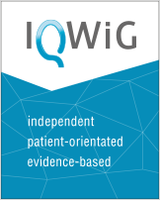NCBI Bookshelf. A service of the National Library of Medicine, National Institutes of Health.
Seasonal affective disorder: Do non-drug interventions such as light and vitamin therapy lead to better results? IQWiG Reports – Commission No. HT18-04 [Internet] Cologne (Germany): Institute for Quality and Efficiency in Health Care (IQWiG); 2021 Apr 14.

Seasonal affective disorder: Do non-drug interventions such as light and vitamin therapy lead to better results? IQWiG Reports – Commission No. HT18-04 [Internet]
Show detailsTwenty-one studies on SAD treatment with data on a total of 1441 adults were found. Sixteen studies compared phototherapy versus placebo, 3 versus cognitive behavioural therapy, and 2 versus the antidepressant fluoxetine. No studies were found which compared phototherapy versus other types of psychotherapy or different antidepressants. For phototherapy, 4 studies used an HMU, while the others used light boxes. Two studies investigated the effect of dawn simulation as well as light box therapy. No studies were found on SAD treatment with vitamin D. Therefore, no conclusions can be drawn on the effectiveness and safety of vitamin D therapy against SAD.
A joint analysis of all types of phototherapy versus placebo resulted in no hint of benefit for the outcomes of response, remission of depression, severity of depressive symptoms, functioning, or AEs. No data are available on the outcomes of mortality or health-related quality of life. Subgroup analyses evaluating light box therapy separately from phototherapy with HMUs differ in results. There are hints of a short-term benefit of light box therapy in comparison with placebo with regard to depression-related outcomes (response, remission, severity of depressive symptoms). There is no hint of any difference in the number of AEs or changes in cognitive functioning. For phototherapy with HMUs, in contrast, no hint of any benefit can be derived with regard to response, remission, severity of depressive symptoms, or AEs. Regarding the outcome of functioning, no data are available for this comparison.
For dawn simulation versus placebo, there is a hint of benefit with regard to response, but none for remission, severity of depressive symptoms, or AEs. No data are available for this comparison regarding the outcomes of mortality, functioning, and health-related quality of life.
In general, long-term effects of phototherapy in comparison with placebo remain unknown since the outcomes were surveyed at the end of the intervention period of 2 to 8 weeks.
A direct comparison with other treatment options provides no hint of light box therapy being of greater benefit in SAD treatment than the antidepressant fluoxetine or cognitive behavioural therapy. After 5 to 8 weeks, all 3 interventions were associated with response or remission rates of about 50%, and the severity of depressive symptoms was comparable. Two studies additionally investigated the long-term effect of light box therapy versus cognitive behavioural therapy, showing similar remission rates after 1 year. There is a hint of fluoxetine causing more AEs during treatment than light box therapy. No such hint was found for cognitive behavioural therapy. Regarding mortality and functioning, no data were available for either the comparison of phototherapy versus fluoxetine nor for phototherapy versus cognitive behavioural therapy. Data on health-related quality of life are available only for the comparison of phototherapy versus fluoxetine, and these data do not provide any hint of greater benefit of phototherapy. No conclusions can be drawn on the benefit and harm of phototherapy in comparison with other antidepressants or other types of psychotherapy because no studies were found on these topics.
At a light box price of EUR100, the intervention costs for 4 weeks of light box therapy, including consultations, amounts to approximately EUR202. Hence, the costs are similar to those of 6 weeks of antidepressant therapy with fluoxetine (approx. EUR184.91 to EUR190.10), but lower than those of cognitive behavioural therapy. The total costs of 4 weeks of cognitive behavioural therapy, administered twice weekly, equal EUR834.67 in a group of 8 and EUR1359.92 for individual therapy. At about EUR182, vitamin D therapy is associated with the lowest intervention costs. In this context, it is worth noting that the cost of a phototherapy device is incurred only once, which is relevant in case of a recurrence of depressive episodes in subsequent winters.
The 2 identified health economic studies compared phototherapy versus cognitive behavioural therapy or no treatment. They were conducted in the United States and the informative value was considerably lower due to methodological limitations. Therefore, their results are not transferable to the German healthcare system.
Currently, German SHIs typically do not cover the costs of phototherapy or vitamin D therapy, while they do cover the costs of treatment with antidepressants and psychotherapy. Drug therapy with antidepressants is currently the most common treatment method for acute SAD. Lack of coverage of therapies can not only influence the choice of treatment, but also promote social inequalities.
Ethical and social challenges related to SAD particularly include societal doubts as to whether SAD is actually a clinical picture or represents a “normal” part of the dark season. In this context, physician awareness of SAD should be promoted in order to prevent its diagnosis or treatment from being delayed or missed. Physicians are also required by law to inform patients about all available treatment options for SAD and to obtain informed consent to treatment. From an organizational perspective, the implementation of phototherapy and vitamin D therapy does not require more personnel, because both therapies can be self-administered by the patient.
- Conclusion - Seasonal affective disorderConclusion - Seasonal affective disorder
- Discussion - Seasonal affective disorderDiscussion - Seasonal affective disorder
Your browsing activity is empty.
Activity recording is turned off.
See more...